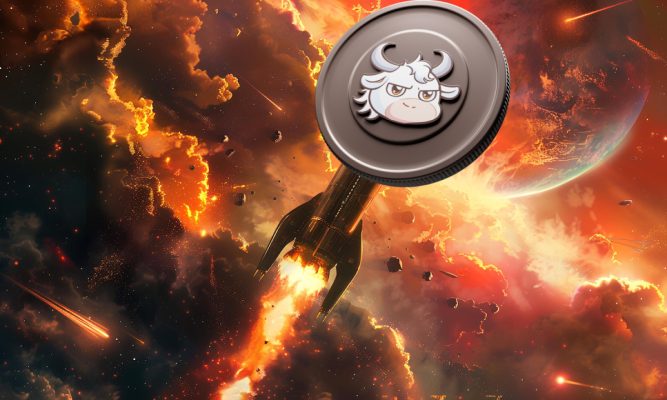Can you name one industry that moves faster than crypto or technology these days? It might be a bit hard, right?
That is mostly because of (or thanks to) the constant updates offered by various companies that always feel (or even know) there can be even more than it already is.
The crypto market is that place where, when you think that things could not get even more interesting, safer, and better, here comes a new concept that improves certain features.
It’s the same with NFTs and SFTs; one of them is well-known, highly praised class of digital assets, while another (guess which) is not so popular although it is truly innovative.
Thus, let’s take innovation and discuss it while making a comparison between NFTs and SFTs.
What Are Non-Fungible Tokens (NFTs)?
If you have been in the crypto space for at least a couple of hours, it’s impossible to not have heard of NFTs, CryptoPunks, or Axie Infinity.
But to refresh the information, NFT (or Non-Fungible Token) is a digital asset that is entirely unique and cannot be traded with a similar asset, as it has a unique identification (metadata, ownership history) on the blockchain that it relies on.
Two NFTs will never have identical attributes, and this makes them one of the most intriguing type of digital assets.
Non-fungible tokens can take many forms, including images (JPEG), music (MP3), videos (MP4), GIFs, and more. And it is this flexibility that makes them widely used in the crypto space. Some of their use cases include:
- In-game assets and the entire gaming industry in general;
- Virtual real estate;
- Art and collectibles;
- Fashion;
- Event tickets;
- Exclusive memberships;
- Luxury goods ownership;
- Metaverse.
In each of these use cases, NFTs provide their holders with a truly valuable concept: ownership.
Each NFT contains data that ensures the ownership of the asset, proving that a specific user is the actual and genuine holder of the digital collectible. It also contains a history of the previous owners and various data about the non-fungible token itself.
NFTs usually use the ERC-721 token standard, which is a protocol that defines the functionality and capability of this type of tokens. ERC-721 also allows for non-fungible token transactions and creation, and each NFT on the Ethereum network must respect the rules and regulations of this standard.
The smart contracts underneath the protocol only allow for sending one NFT per transaction, and this, combined with the fact that Ethereum is already crowded, can make transaction costs go higher than some would expect.
NFTs’ Main Advantages
As you have probably already realized, NFTs come with numerous valuable features, and while their advantages are plenty, there are some that you will hear pretty often:
They Prove Ownership and Authenticity
As we mentioned earlier, NFTs contain metadata that allows to prove the ownership and authenticity of digital art. This makes digital collectibles easier to transfer and especially sell, while also protecting them, their buyer, and their seller.
For instance, let’s say you create a digital artwork and want to transform it into a non-fungible token. Your NFT can be traced back to you, its original creator, and this confirms the authenticity and ownership history of the certain NFT.
They Are Easily Transferable
Since the very first NFT was developed and released, this digital asset class was specially designed to be easily transferable.
These days, you can find them on almost any crypto exchange out there, making it extremely easy for you to buy, sell, or list an NFT without the need of a third-party.
This streamlines every NFT-related activity and makes this digital asset class increasingly accessible to crypto enthusiasts from all over the world.
They Are Transparent
We all know that crypto in general is surprisingly transparent, and this, along with privacy, security, and decentralization, are the advantages that made over 575 million identity-verified crypto asset users choose this type of investment in the first place.
And as the apple does not fall far from the tree (and it could not, basically), NFTs “borrow” the transparency provided by blockchain technology. Given this advantage, you can easily learn what there is to know about a certain NFT, like its previous ownership, authenticity, and more.
This can increase trust in non-fungible tokens and make even more users choose to invest in at least one.
They Offer New Revenue Streams
Last but not least, NFTs can be used to generate new revenue streams for both creators and owners. If you’re an artist and decide to sell your work as non-fungible tokens, you can sell your work as unique and ensure that it will not be replicated ever (or at least it should not be).
Once you become popular with your art (or if you already are), you can offer your fans the opportunity to purchase digital copies of certain things you created, thus offering them a piece of your art that ensures them it is legitimate.
Downsides of NFTs
Just like any other thing in life, although there are not as many as the advantages, the downsides of NFTs do exist:
- They are susceptible to the market’s volatility (after all, they are crypto assets);
- There may be some scams out there, and this is why it is essential to thoroughly research an NFT project before investing in it;
- As safe and transparent as they might be, they can be part of thefts and frauds.
Top 3 NFTs
The Merge

“The Merge” is the most expensive NFT ever sold. It was designed by Pak (formerly known as Murat Pak), a prominent NFT artist well known for creating some of the most popular digital collectibles ever sold.
The NFT was auctioned on December 6, 2021, on Nifty Gateway and contains 312,686 individual pieces which, at the time, were held by 28,983 investors. Its price? A tremendous amount of $91.8 million.
Everydays: The First 5,000 Days

Beeple (Mike Winkelmann) is another extremely popular artist who took 5,000 days to design a stunning NFT called “Everydays: The First 5,000 Days.” The digital collectible contains 5,000 drawings created over the span of 5,000 days.
Everydays: The First 5,000 Days was sold in March 2021 at a Christie’s auction for $69,346,250. The intriguing thing about this auction? The first bid was approximately $100. Furthermore, this NFT marks the first time in NFT history when a major auction house organized an event for digital NFT art.
Clock

The story behind “Clock,” an NFT developed by Pak, is deeper than some might think. The digital artwork was created to include a digital clock related to Julian Assange, WikiLeaks’ founder, and his 2019 conviction. Clock was sold for $52,740,000 in February 2022.
We recommend reading “20 Most Expensive NFTs Ever Sold.”
What Are Semi-Fungible Tokens (SFTs)?
To give a short answer, an SFT (Semi-Fungible token) is a combination between NFTs and FTs (Fungible Tokens, the cryptocurrencies we all are used to).
Basically, semi-fungible tokens are a digital asset class that takes the key features of NFTs and cryptocurrencies and combines them to offer a solution that comes with more accessibility and, most importantly, increased usability.
The magic behind a semi-fungible token? Well, it is fungible until it becomes non-fungible. But how does that happen? And most importantly, when does that happen?
Well, an SFT is fungible until it meets a specific requirement that allows it to be non-fungible. For example, if you want to go to a festival that sells passes in the form of digital assets, you will first receive a fungible token, as all the passes would be the same.
Until the beginning of the festival, you can trade the passes just like you trade multiple tokens that have the same value. They all are interchangeable.
However, the magic happens once the festival passes. Then, the smart contract of the digital asset self-executes and turns your ticket into an NFT, a unique asset linked to your experience during the festival.
How Do SFTs Work?
SFTs use a different token standard: ERC-1155. This protocol was created by blockchain gaming developers The Sandbox, Horizon Games, and Enjin as a solution to manage both FTs and NFTs using a single smart contract.
This allows for higher speed in processing in-game actions, as well as a lower possibility of reaching network congestion and lower gas fees. Each of these is a great advantage that semi-fungible tokens can bring to the blockchain gaming table.
SFTs Use Cases
Semi-fungible tokens can be used in increasingly more situations thanks to the fact that they behave as both fungible and non-fungible tokens. They can have an increased value once they turn into an NFT, and in the meantime, they can be easily traded among crypto enthusiasts.
Although SFTs are useful primarily in the gaming industry, their use cases diversify with each day that passes. For instance, at the moment, they can also be used like we described above: to sell tickets or offer vouchers.
Moreover, take the RTFKT x Nike AR Hoodie project: the team allows SFT holders to burn their ERC-1155 token and receive an ERC-721 one along with their limited edition hoodie with AR features.
NFTs vs SFTs – The Final Battle
And the winner is…
Well, both.
NFTs and SFTs come with significant advantages, but their use cases slightly differ. For instance, they both can be used in crypto games as in-game assets, but each will have its purpose there. NFTs will be offered for significant in-game achievements, while SFTs can be offered for other actions performed in the game.
Furthermore, let’s not forget that the ERC-1155 standard was developed for situations where NFTs and FTs have to work together. ERC-1155 makes it possible to use a single smart contract for that.
Besides, an NFT artist might never want to sell their long-worked artwork as a fungible token. They will also go the non-fungible way.
Thus, it is safe to say that NFTs and SFTs coexist in genuine harmony in the crypto space, each making certain processes or concepts easier to deal with while focusing on maintaining the authenticity of a digital collectible and streamlining the relationship between NFTs and FTs, respectively.
FAQ
Is NFT better than crypto?
NFT is part of the crypto industry and adds “a little bit of spice” by offering users the remarkable opportunity to own entirely unique digital assets that contain proof of their authenticity and ownership history. Both NFTs and cryptocurrencies have their advantages and downsides, but their use cases and technology are (slightly) different.
What is the difference between NFTs and SFTs?
NFTs are non-fungible, meaning that they are unique and cannot be exchanged with other NFTs. On the other hand, SFTs are fungible in the first place, and once they meet a specific value or condition, they become non-fungible.
What are the use cases of SFTs?
Semi-fungible tokens can be used in crypto games to offer in-game rewards. Besides, they can be used to sell tickets or offer vouchers that, once used, become non-fungible.
In Conclusion
The world of digital assets continues to surprise us with new concepts that aim to improve a certain feature or process in the industry. When it comes to NFTs, they are enough intriguing as they are, but it is sometimes hard to deal with them in the gaming industry, especially when you also want to offer other types of tokens, too.
Thus, SFTs (Semi-Fungible Tokens) were developed so that crypto games have a way to offer both NFTs (Non-Fungible Tokens) and FTs (Fungible Tokens) by using the same smart contract.
SFTs act like a fungible token until they meet a certain condition, and from that moment on, they are non-fungible tokens. A good example is a ticket that, until used, is a fungible token, and once the event passes, it becomes non-fungible.

